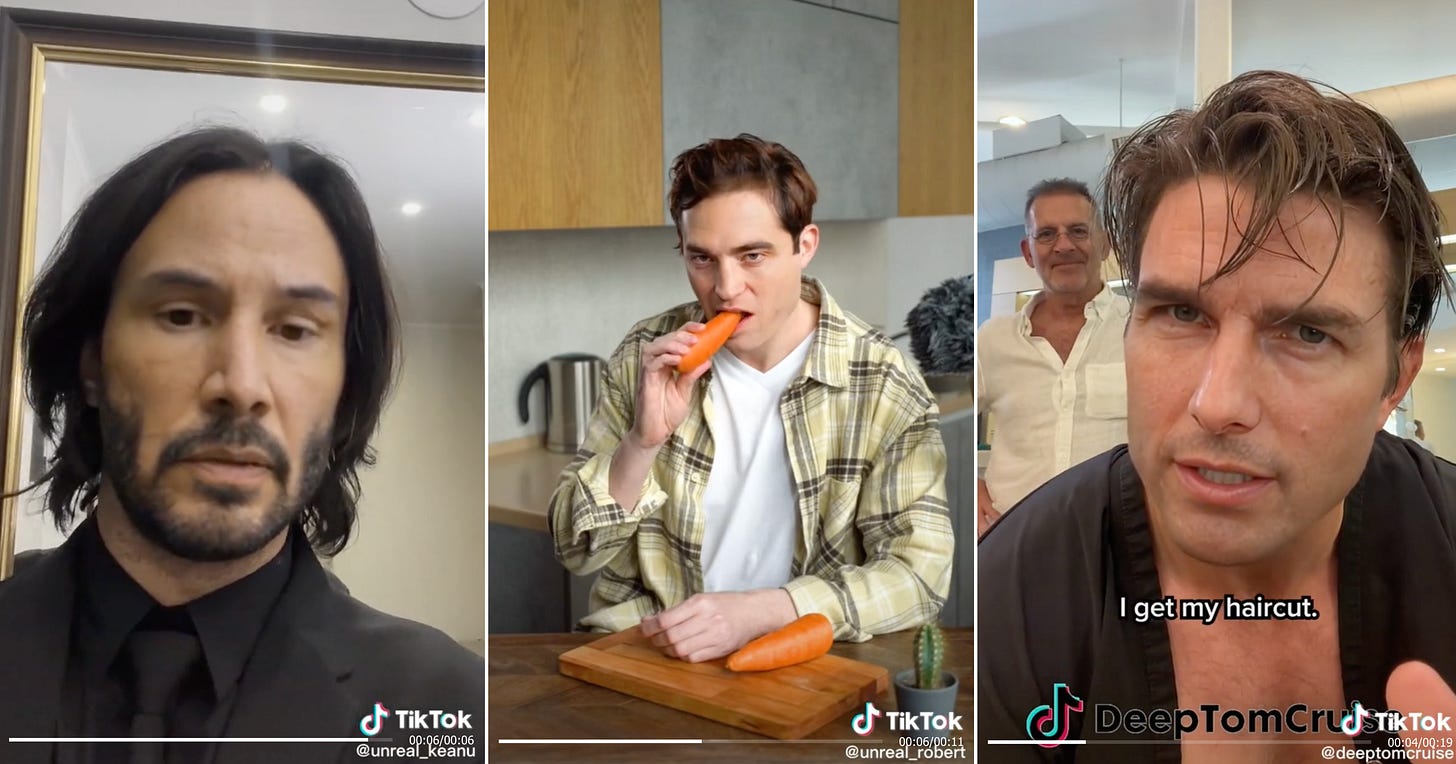Hello World!
This is Understanding TikTok. My name is Marcus. And i am really sorry for not having posted in recent days and weeks. I was moving house and stuff. And stumbled. Just like Instagram where users cumulatively are spending 17.6 million hours a day watching Reels, less than one-tenth of the 197.8 million hours TikTok users spend each day on that platform, internal documents show (WSJ).
Today we talk about:
🤡 Deepfakes
🗽State of TikTok
🤡 Deepfakes
Experts estimate that as much as 90 % of online content may be synthetically generated by 2026 (Europol). Let’s talk about deepfakes for a bit. Deepfakes (a portmanteau of "deep learning" and "fake") are synthetic media in which a person in an existing image or video is replaced with someone else's likeness. More: What is a deepfake (Insider).
Deepfakes are taking over TikTok — here’s how you can spot them, was the headline of an article from July (Neural). It included amongst others Tom Cruise, Keanu Reeves and Robert Pattinson. They are not real. But she is. And he 👇 is too.
Curt Skelton (22-year-old Los Angeles college student and liquor store employee) convincingly (to some) revealed that he is AI-generated (Input Magazine). He is not. But he sparked a discussion that “highlights the fear around deepfaked media and the ability for people to be hoodwinked by AI.”
According to the Community Guidelines TikTok bans “Digital Forgeries (Synthetic Media or Manipulated Media) that mislead users by distorting the truth of events and cause significant harm to the subject of the video, other persons, or society.” But they are there. Just check out deepfake Zelenskyy or deepfake Putin.
It is still early days for the discussion and possible regulation of synthetic media, but if you want to dive deeper i recommend the report JUST JOKING! Deepfakes, Satire, and the Politics of Synthetic Media. It is part of an ongoing collaboration, Deepfakery, between WITNESS and Co-Creation Studio at MIT Open Documentary Lab. By the way: They have a great playlist too.
🗽 State of TikTok
TikTok is making it easier for researchers to delve into the data and protocols that make up the platform. Well at least TikTok COO Vanessa Pappas announced that the company will soon grant researchers access to the framework behind the platform and its moderation system in a blogpost from July 27. May i ask: How soon is now?! (yes).
Meanwhile researchers are discussing best ways on how to scrape the platform. Compare #80 (🔬New TikTok Tool).
Martin Degeling from Stiftung Neue Verantwortung – a German non-profit think tank based in Berlin – is investigating the platform. He has used automated bots to collect data from around 220.000 TikTok videos. We did a little interview about his latest TikTok research:
Could you please introduce yourself in 2-3 sentences?
I'm a computer scientist and researcher at Stiftung Neue Verantwortung, a non-profit think tank working on current political and societal challenges posed by new technologies. My current project focuses on audits for recommendation systems of social media platforms/providers as they have been outlined, but not specified, in the EU digital services act.
Which research questions did you have when investigating TikTok?
While our goal is to develop generalized guidelines for auditing platforms that heavily rely on recommenders, TikTok is our first test case. We wanted to understand what drives the recommender, what content is shown, and how user interactions influence it. So we started with an automated bot that watched or skipped videos to see what came next and captured all the available metadata.
What did you find out?
We are still in the process of analyzing the data but have spent most of the time looking at topics (in the form of hashtag clouds) presented on the ForYou page of new users. In general, the data supports that TikTok is, first and foremost, an entertainment platform. It recommends overwhelmingly "funny" or "satisfying" videos to new users. And: Things get old pretty quickly. We did not see content older than three months offered to first-time visitors.
What surprised you the most?
While we observed the German TikTok site, we still found a lot of international content from around the globe that gets featured; this is unique. While I was impressed by the diversity of *who* is shown, *what* is shown often remains within stereotypical boundaries. For example, one large sub-cluster of the funny videos is related to "#coupleshumor," featuring rather old-school heterosexual stereotypes of men and women.
From a data science perspective, it is also interesting to see how the system of "hashtags" evolves on TikTok. While nearly everybody uses some form of "#fyp" - rendering it useless, there are also 18% of videos that do not use hashtags at all, and still get featured.
Could you describe your next steps please?
We are extending our analysis and trying to understand how the recommender works. We want to understand if certain risks, like rabbit holes (still) exist, but also how persistent they are. Although it is often assumed that there is a *tok for every topic. While it is pretty easy to, e.g., end up watching an endless stream of depressing quotes, we can't confirm this for every right now. We are not sure, yet, whether there just not enough content for some topics, or the recommender does not allow us to enter some “rabbit holes.”
Could you shortly explain what your data viz shows and how to use it.
The visualization (created with Gephi) shows the co-occurrences of hashtags for about 220.000 videos we scrolled between June and August on the German TikTok website. The larger the circle (representing a hashtag), the more often it appeared in the data set. When you click a circle, it highlights those connected, meaning that appeared together in a video description. The thickness of the line connecting two circles indicates how often they showed up together. We removed several hashtags that rendered the graphic unusable because they were over-represented and did tell us nothing about the content, e.g., variants of "fyp", "fürdichseite" or"capcut".
Me Me Me
🔦 If you happen to understand german i recommend a big media package from german public broadcast content network funk. They produced a TikTok special called DarkTok with a lot of interesting stuff. A talk show with among others Jeremy Fragrance, a deep dive into the drug scene on TikTok (YouTube) and everything you need to know about the AfD’s TikTok strategy (YouTube) – AfD is a right-wing populist political party in Germany. Yes, you will find my pretty face talking to camera about that.
👔 I talked to LA Times about politicians on TikTok and the midterm elections. By chance i came up with a new word. It is called ✨ meta cringe moments ✨. They happen pretty often on the platform when something is so cringe that it actually turns into something pretty cool or at least interesting.
🌽 Audio-Memes are a thing. The New York Times wrote about it. And then It’s corn happened. I talked to Deutschlandfunk Kultur about meme songs, suitable sounds and the entire phenomenon.
🇺🇦 Anton Gerashchenko, advisor to the Minister of Internal Affairs of Ukraine is sharing TikTok videos that are supposingly showing ukrainian soldiers at the front (playing the violin or singing birthday songs to kids in order to proof the peaceful and honorable faces of defenders). A great reminder that WarTok is still a thing. Public broadcaster MDR reports “Von TikTok zu WarTok” – including some quotes chez moi.
🤳And then there was a six page report in german magazine Focus on Weltmacht TikTok (World Power TikTok) with some quotes and i am happy to send you the PDF i got if you want. Enough of me now.
More TikTok stuff that happened in recent weeks can be found over on Twitter (@tiktoktactics). Speak soon. Ciao.








